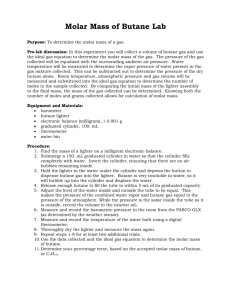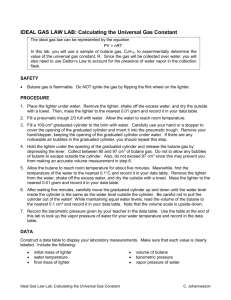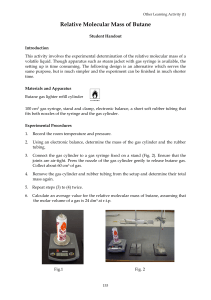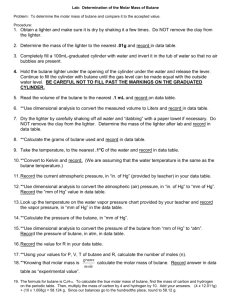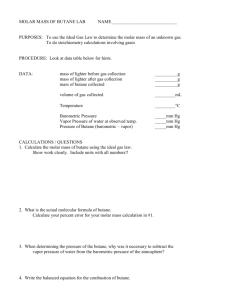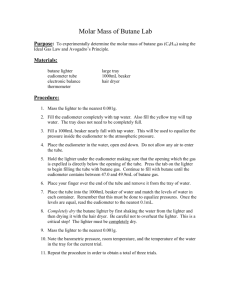Determining the Molar Mass of a Gas ABC
advertisement
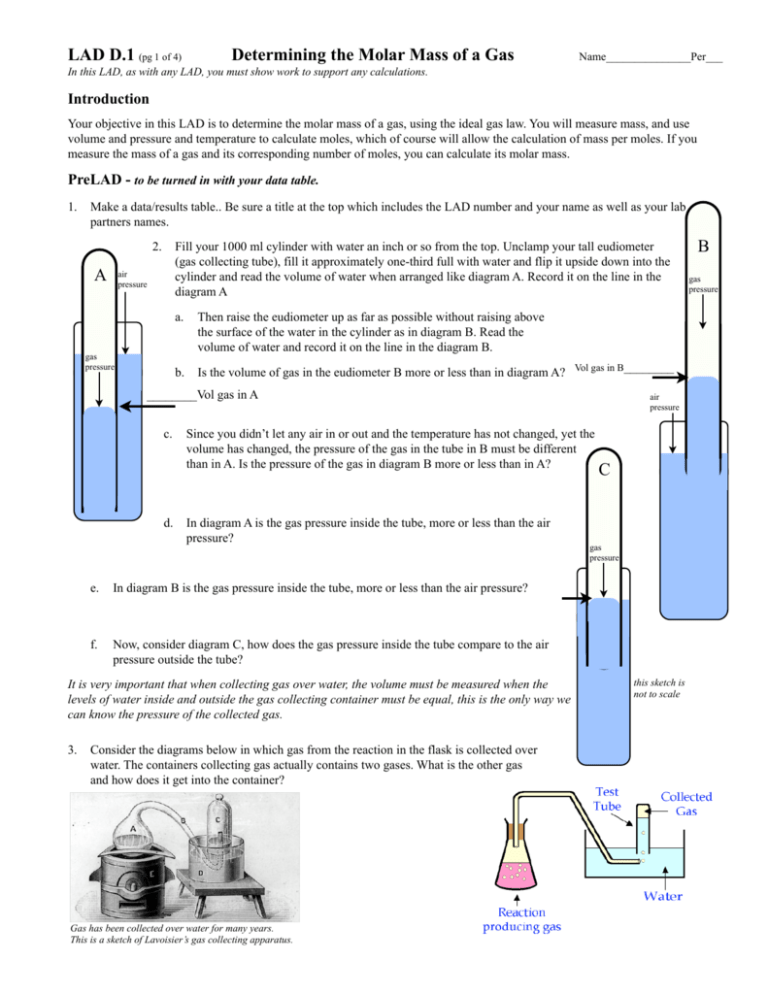
LAD D.1 (pg 1 of 4) Determining the Molar Mass of a Gas Name_______________Per___ In this LAD, as with any LAD, you must show work to support any calculations. Introduction Your objective in this LAD is to determine the molar mass of a gas, using the ideal gas law. You will measure mass, and use volume and pressure and temperature to calculate moles, which of course will allow the calculation of mass per moles. If you measure the mass of a gas and its corresponding number of moles, you can calculate its molar mass. PreLAD - to be turned in with your data table. 1. Make a data/results table.. Be sure a title at the top which includes the LAD number and your name as well as your lab partners names. 2. A Fill your 1000 ml cylinder with water an inch or so from the top. Unclamp your tall eudiometer (gas collecting tube), fill it approximately one-third full with water and flip it upside down into the cylinder and read the volume of water when arranged like diagram A. Record it on the line in the diagram A air pressure gas pressure a. Then raise the eudiometer up as far as possible without raising above the surface of the water in the cylinder as in diagram B. Read the volume of water and record it on the line in the diagram B. b. Is the volume of gas in the eudiometer B more or less than in diagram A? Vol gas in B________ ________Vol gas in A c. d. Since you didn’t let any air in or out and the temperature has not changed, yet the volume has changed, the pressure of the gas in the tube in B must be different than in A. Is the pressure of the gas in diagram B more or less than in A? In diagram A is the gas pressure inside the tube, more or less than the air pressure? e. In diagram B is the gas pressure inside the tube, more or less than the air pressure? f. Now, consider diagram C, how does the gas pressure inside the tube compare to the air pressure outside the tube? It is very important that when collecting gas over water, the volume must be measured when the levels of water inside and outside the gas collecting container must be equal, this is the only way we can know the pressure of the collected gas. 3. air pressure Consider the diagrams below in which gas from the reaction in the flask is collected over water. The containers collecting gas actually contains two gases. What is the other gas and how does it get into the container? Gas has been collected over water for many years. This is a sketch of Lavoisier’s gas collecting apparatus. C gas pressure this sketch is not to scale B gas pressure LAD D.1 (pg 2 of 4) Determining the Molar Mass of a Gas Understanding Vapor Pressure of a Liquid • When a liquid evaporates to a gas (vapor) in a closed container, the gaseous molecules cannot escape. • Some of the vaporized molecules will eventually strike the liquid phase and condense back into it. • When the rate of condensation of the vapor becomes equal to the rate of evaporation of the liquid, the amount of vapor will have reached a maximum and will no longer change. • The gas in the sealed container is in equilibrium with the liquid. • The pressure exerted by the water vapor in equilibrium with the liquid water in a closed container at a given temperature is called the vapor pressure. • Vapor pressure is dependent only on temperature: at a higher temperature, more molecules have enough energy to escape from the liquid or solid. At a lower temperature, fewer molecules have sufficient energy to escape from the liquid or solid. 4. Let’s take a closer look at two gases in a container. Dalton’s Law of Partial Pressures says that each gas will independently cause pressure and that each gas will contribute to the total pressure. Ptotal = Pgas1 + Pgas2 Calculate the total pressure in container Z in which the two gases in X and Y have been combined in container Z. H2O Pressure 16 mmHg X + O2 Pressure 739 mmHg Y = H2O O2 Total Pressure ?? atm Total pressure (in atm)__________ Z Equilibrium Water Vapor Pressure 5. Consider the scenario in the diagram below. Use the Equilibrium Water Vapor Pressure Table to the right to calculate the pressure of the collected gas. Temp = 23ºC Air Pressure 755 mmHg 6. Write the Ideal Gas Law in the space below, • • and then substitute for moles: n = mass/molar mass and then manipulate the variables and solve for molar mass. Temp (ºC) Pressure (mm Hg) Temp (ºC) Pressure (mm Hg) 0 5 10 11 12 13 14 15 16 17 18 19 20 21 22 23 24 25 26 27 28 29 30 4.58 6.54 9.21 9.80 10.52 11.20 11.99 12.80 13.63 14.53 15.48 16.48 17.54 18.65 19.83 21.07 22.38 23.76 25.21 26.74 28.35 30.04 31.82 35 40 45 50 55 60 42.2 55.3 71.9 92.5 118.0 149.4 65 70 80 90 92 94 96 98 100 102 104 106 108 110 187.5 233.7 355.1 525.8 567.0 610.9 657.6 707.3 760.0 815.9 875.1 937.9 1004.4 1074.6 Materials − on trays to be shared by two lab groups • • • • • • • • 2x 100 ml glass graduated cylinder 2x lighter matches thermometer 2 x “hot hands” grippers sink drain stop tissues & paper towels bucket and sponges for bench clean-up Center Lab Bench • Analytical (0.0001) balance In the Lab sink • dish pan with very soapy water PreLAD • 2x 1000 ml graduated cylinder and 2x gas collecting tube LAD D.1 (pg 3 of 4) Determining the Molar Mass of a Gas Name_______________Per___ Procedure A. Weigh the lighter. B. Prepare the graduated cylinder to collect gas by filling it with water in the sink and inverting it mouth down. Dunk the lighter under water and allow butane to flow out of the lighter until you have collected 80 − 95 ml of gas. • Write down two good reasons why 90 ml of gas would be better than only 20 ml of butane C. Measure the volume of gas when you have raised or lowered the cylinder so that the level of water inside the tube and the surface of water in the sink are the same. At that moment, read the volume of gas in the cylinder. D. After drying of the lighter VERY thoroughly, weight the lighter again. Keep track of your lighter until after performing your calculations, because you may find that it was still wet and you need to weigh it again. When finished, leave the lighter on the tray. E. Use the thermometer to record the temperature of water in the sink and the temperature of the air in the room - we hope that they are the same. (If they are not, take an average, since you can use only one value in your calculation.) F. Using the vapor pressure chart, record the equilibrium vapor pressure of water for the temperature of water/air in the room on your data table. G. Record the air pressure in the room. It has been checked on-line and recorded on the whiteboard. H. Just for fun − Put on eye-wear and hold your cylinder at the bottom with the “hot hands” grippers. Then you can light the butane. Observe whether the gas flows up and out of the cylinder, or whether you need to pour it out. When you finish, there will probably be carbon-soot deposited on the cylinder. Please go to the very soapy dish tub at the sink in the back and wash the cylinder before you put it back on the lab tray. Process the Data − Use this as a work space if you wish, but you must put these results and 1. method of calculation on your data table. Calculate the mass of butane that was released into the cylinder. 2. Calculate the partial pressure of the butane in the cylinder. Use the water vapor pressure table given in the PreLAD. 3. Using your literal equation in which you solved for molar mass in the preLAD, calculate the molar mass of butane. 4. Write out the chemical formula of butane. Use the periodic table to calculate the molar mass. 5. Calculate the percent error for your experimental molar mass calculation. LAD D.1 (pg 4 of 4) Determining the Molar Mass of a Gas Post-LAD Questions - to be answered on this sheet in the spaces provided. Calculations must be shown. 1. Comment on the following sources of error and how they would affect the molar mass. Justify your answer by stating the error’s effect on any measurements and following those effects through the resulting calculations. Be specific by stating if the measurements and calculations would be higher or lower as a result of the source of error. What if…… a. the lighter were still wet when you measured its mass? b. you had a goofy lab partner who decided to open the valve let out some butane on the way to the balance before the final weighing of the lighter? c. you measured the volume of your butane when the graduated cylinder looked like the diagram to the right? Gas volume measured when above the surface of water in sink. 2. Most Bic lighters hold 5 ml of liquified butane (density = 0.6 g/ml) Calculate the minimum size container you would need to “catch” all of this butane at room conditions, if you released it from the lighter. 3. Write a balanced equation for the combustion of butane. 4. What volume of air at today’s lab conditions would be required to combust a full lighter of butane. Remember that air is only ~20% oxygen. 5. What would be the total volume of gases produced (at today’s room conditions) by the combustion described in the previous question.
